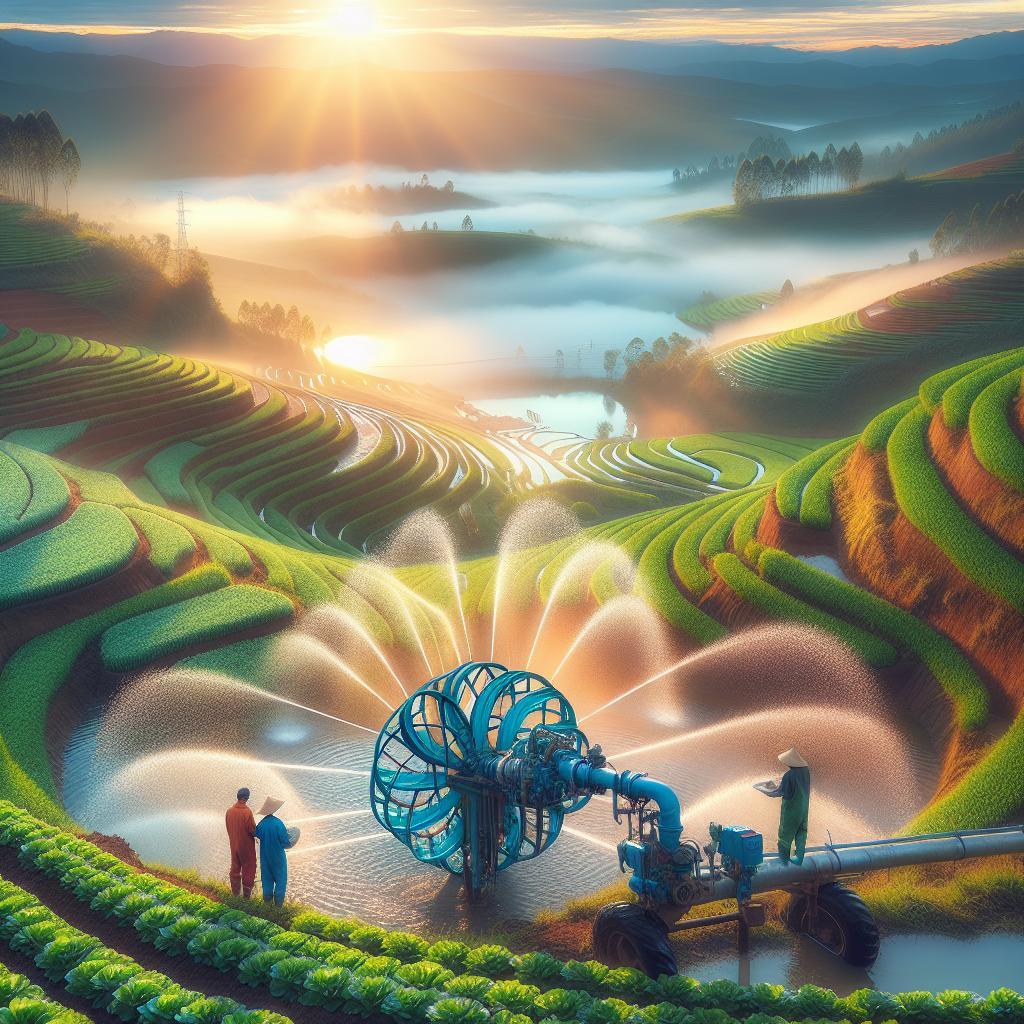This post may contain affiliate links which means I may receive a commission for purchases made through links. Learn more on my Private Policy page.
Optimizing teh Performance of Your Farm Irrigation Pump: A Pumping Good Guide!
Welcome, fellow farmers and green-thumbed enthusiasts! If you’ve ever stood in your field, watching the droplets of water dance across your crops, you know that a reliable irrigation system can make all the difference between a bountiful harvest and a parched landscape. Among the unsung heroes of your irrigation setup is the humble pump – a powerhouse that quietly ensures each plant receives the hydration it craves. But what if we told you that with a few tweaks and a sprinkle of know-how, you could supercharge your farm irrigation pump’s performance?
In this amiable guide, we’ll explore practical tips and innovative techniques to not just maintain your pump but optimize its efficiency and effectiveness. Whether you’re a seasoned farmer or just starting your agricultural adventure, our journey into the world of irrigation pumps promises to be both enlightening and enjoyable. So grab your sun hat,roll up those sleeves,and let’s dive into the art of keeping your pump – and your crops – flowing smoothly!
Understanding your Pump: Choosing the Right Type for Maximum Efficiency
Choosing the right pump for your irrigation system can significantly enhance the water distribution and efficiency of your farm. The first step is to assess your specific needs based on several factors, including the size of your fields, the crop types, and the geography of your land. Hear are some options to consider:
- Centrifugal Pumps: Ideal for low-viscosity fluids, these pumps offer great flow rates and are suitable for applications requiring a large volume of water.
- submersible Pumps: Perfect for deep wells, these pumps can operate underwater and are highly efficient in moving water from great depths.
- Diaphragm Pumps: Known for handling thicker fluids and versatile applications, these pumps are excellent for situations involving fertilizers or chemicals.
- Gear Pumps: Used for precision applications, they deliver consistent flow rates and are great for low-flow situations.
Understanding the horsepower and flow rates of each pump type is crucial for maximizing your system’s efficiency. Here’s a quick reference table to help you gauge the suitable horsepower based on your irrigation requirements:
| Flow Rate (GPM) | Horsepower Required |
|---|---|
| 10-20 | 1-2 |
| 21-40 | 2-3 |
| 41-60 | 3-5 |
By selecting the right type and understanding their specifications, you can tailor your irrigation system to the unique demands of your farm, ensuring robust crop health and maximum water usage efficiency.

Tuning Up for Success: Routine Maintenance Tips to Keep Your Pump Running Smoothly
Regular maintenance is essential for ensuring that your irrigation pump operates at peak efficiency. Start by establishing a maintenance schedule that aligns with the demands of your crops and seasonal changes. Key activities should include:
- Inspecting filters for clogs and cleaning them to prevent pressure drops.
- Checking seals and gaskets for wear and replacing them to avoid leaks.
- lubricating moving parts according to manufacturer recommendations to minimize friction.
- Testing electrical connections to ensure a reliable power supply.
- Monitoring fluid levels to keep the pump functioning properly.
Moreover, it’s crucial to pay attention to the pump’s surroundings.A clean and well-maintained environment can significantly enhance performance. Consider the following aspects:
- Clean the intake area to prevent debris from entering the pump.
- Ensure proper drainage around the pump to avoid water accumulation and corrosion.
- Maintain adequate ventilation to prevent overheating during operation.
- Inspect hoses and connections for wear and tear to avoid any unexpected breakdowns.
| Maintenance Task | Frequency |
|---|---|
| Inspect Filters | Monthly |
| Check Seals & Gaskets | Every 6 Months |
| Lubricate Moving Parts | Quarterly |
| Test Electrical connections | Annually |
| Monitor Fluid Levels | Weekly |

Smart Water Management: Implementing Technology for Precision Irrigation
Advancements in technology have transformed how farmers approach irrigation, enabling them to optimize water usage without sacrificing crop yield. By implementing precision irrigation systems, you can monitor and adjust water submission in real-time based on specific crop needs and environmental conditions. Here are a few technologies that are revolutionizing water management:
- Soil Moisture Sensors: These devices provide real-time data on soil hydration levels, allowing farmers to irrigate only when necessary.
- Drip Irrigation: A highly efficient method that delivers water directly to the plant roots through a network of tubing.
- Weather Forecasting tools: accurate weather predictions help in planning irrigation schedules, reducing unnecessary watering.
- automated Irrigation Systems: These systems can be programmed to activate based on soil moisture data or weather conditions, ensuring consistent water delivery.
Investing in smart irrigation technology also aids in energy conservation, notably when it comes to your irrigation pump. By optimizing pump performance through variable frequency drives and proper system design, you can reduce energy consumption while maintaining efficient water distribution. Consider the following tips to enhance pump efficiency:
| Tip | Description |
|---|---|
| Regular Maintenance | Keep the pump clean and well-maintained to ensure maximum performance and longevity. |
| Right Sizing | Select a pump that matches your irrigation system’s needs to avoid excess energy waste. |
| Seal Leaks | Regularly inspect and repair any leaks in the system to prevent water and energy loss. |

Powering Down Waste: Energy-Saving Strategies to Boost Your Farm’s Bottom Line
When it comes to enhancing the efficiency of your farm’s irrigation pump, it’s crucial to consider both the energy consumption and the overall operational effectiveness. Start by undertaking a thorough system audit to identify inefficiencies in your current setup. It’s essential to assess your pump’s capacity against the needs of your crops. A pump that’s too large can waste energy, while one that’s too small may not supply sufficient water. Here are some strategies to ensure optimal performance:
- Regular Maintenance: Schedule regular checks to clean filters, inspect for leaks, and evaluate the pump for wear and tear.
- Automate Timing: Utilize smart timers to schedule irrigation based on weather conditions and soil moisture levels.
- Analyze Pressure Levels: regularly monitor pressure levels to ensure they’re within a range that maximizes efficiency without damaging the system.
Additionally, incorporating energy-efficient technologies can dramatically reduce operational costs. Consider investing in a variable frequency drive (VFD), which allows you to adjust the pump’s speed according to demand, saving both energy and money. A simple cost analysis table can definitely help you understand the return on investment:
| Investment | Potential Savings | Payback Period |
|---|---|---|
| Variable Frequency Drive | 20% reduction in energy costs | 2-3 years |
| Drip Irrigation System | 30% water savings | 1-2 years |
| Smart Sensors | 15% reduction in overwatering | 1 year |
Implementing these energy-saving strategies not only boosts your bottom line but also contributes to a more lasting farming practice. By optimizing your irrigation pump’s performance, you ensure a healthier yield and a brighter future for your agricultural enterprise.
Wrapping Up
In the grand tapestry of farming, where every drop of water counts, optimizing the performance of your irrigation pump is akin to tuning a finely crafted instrument.By taking these steps, you’ve not only ensured that your crops receive the lifeblood they need to flourish, but you’ve also embraced sustainability and efficiency—two golden keys to a thriving agricultural future.
As you venture forth, remember that each adjustment, each thoughtful decision, is a step toward a more productive and eco-friendly farm. Whether you’re a seasoned farmer or just starting out, the path to perfecting your irrigation system can be a rewarding journey filled with discovery.
So go ahead—roll up your sleeves, experiment with new techniques, and don’t hesitate to share insights with fellow farmers. Together, let’s nurture the land we love and cultivate a bountiful tomorrow. After all, in the world of farming, collaboration and innovation are as vital as the seeds we sow. Happy farming!
This post may contain affiliate links which means I may receive a commission for purchases made through links. Learn more on my Private Policy page.

